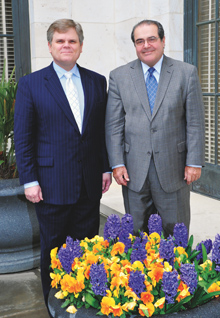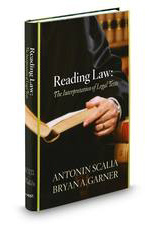Scalia and Garner Release 567-Page Tome on Textualism

Bryan A. Garner and Justice Antonin Scalia
(Photo courtesy of Thomson/West)
The operative sentence in the 567-page book by U.S. Supreme Court Justice Antonin Scalia and writing professional Bryan A. Garner is this: “Our approach is … prescribing what, in our view, courts ought to do with operative language.”
It’s the nature of that operative language that so thoroughly defines Scalia’s approach to legal argument; that is, the necessity of finding the words’ textual meaning. Garner, the editor-in-chief of Black’s Law Dictionary, also subscribes to that theory.
In Reading Law: The Interpretation of Legal Texts, published this week by Thomson/West, the two writers have elaborated in great depth on what textualism means, and have spelled out 70 canons, or guideposts, to explain the concept and how to understand it.
It is the second major book on legal thinking and writing by Scalia and Garner. In 2008 the writers published, also through West, Making Your Case: The Art of Persuading Judges, a guide on how to write clearly and to construct a cogent argument. (See May 2008 ABA Journal, “A Voice for the Write.”)
In addition, Scalia has made it his continuing purpose to explain textualism, his philosophical core. In 1997, the justice published A Matter of Interpretation, an explanation of how to read and interpret statutes. He also explains his notion of originalism, explaining statutory writing as embodying its creators’ intent, rather than judges imposing their own.
Describing Reading Law, Scalia told West that the “goal in posing these unique yet fundamental questions in our new book is to help attorneys better understand how to present a client’s case to the judiciary by better understanding how judges interpret cases.”

Cover image from Thomson/West
Scalia and Garner begin with a workable definition of textualism: “We look for meaning in the governing texts, ascribe to that text the meaning that it has borne from its inception, and reject judicial speculation about both the drafters’ extratextually derived purposes and the desirability of the fair reading’s anticipated consequences.”
Textualists do not give new content to a statute but “merely apply the content that has been there all along,” say the authors. The key word in that phrase is “merely,” because the book’s bread and butter are its canons on how to denote when legal writing follows textual principles. They are extensive, but interesting reading, with multiple footnotes that point the interested reader toward the historical writings garnered from American and English legal history.
The canons also include a section called “Thirteen Falsities Exposed,” telling aspiring textualists what to avoid. For example, steer clear of the “half-truth that consequences of a decision provide the key to sound interpretation.” And avoid the “false notion that remedial statutes should be strictly construed.”
But for Scalia and Garner, textualism and original intent comprise “the only approach that is compatible with democracy.” The Constitution created Congress with a purpose, the writers say, and courts should respect legislators’ language and culture.
Reading Law is an extensive undertaking, deeply thought out with an abundance of fascinating historical references. It is not for casual reading. But it deserves a worthy place on any lawyer’s bookshelf.



